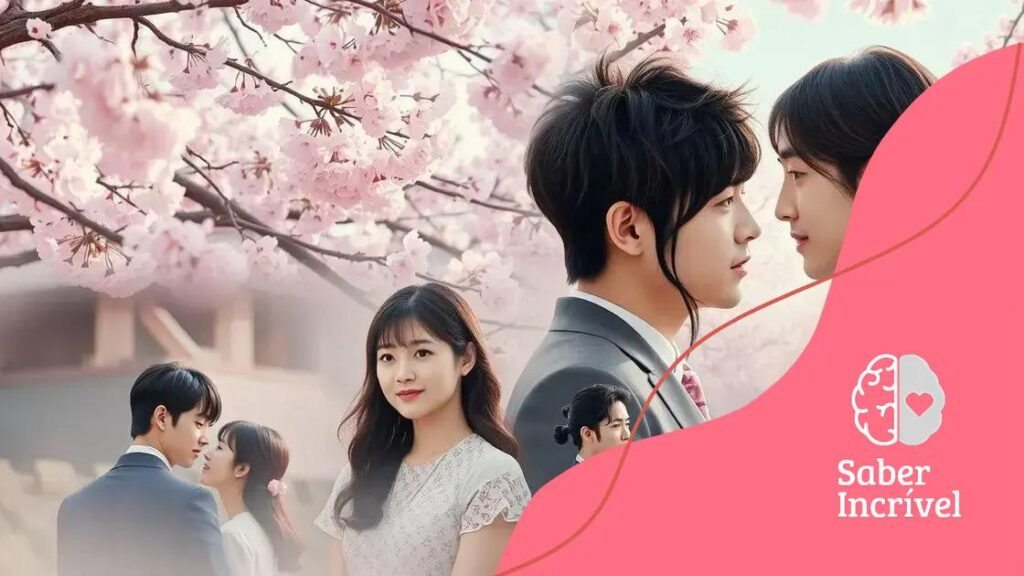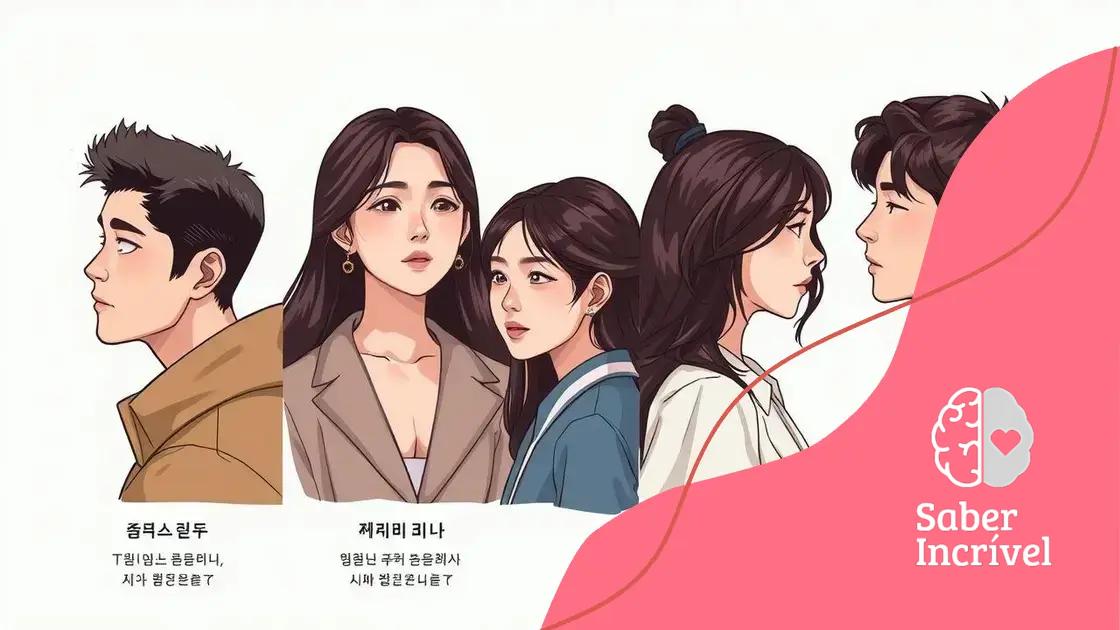The ultimate K-drama cliché dictionary for fans

K-drama clichés play a crucial role in shaping emotional connections, enhancing viewer engagement, and providing familiar storytelling elements that resonate with audiences, blending predictability with unexpected twists.
The ultimate K-drama cliché dictionary invites you to dive into the enchanting world of K-dramas, where familiar tropes and storylines bring both charm and laughter. Ever wondered why certain scenarios repeat? Let’s unravel these beloved clichés!
Understanding K-drama clichés
Understanding K-drama clichés is like discovering a treasure map filled with familiar paths and beloved tropes. These recurring elements often define the heart and charm of K-dramas, making them instantly recognizable to fans.
What are K-drama clichés?
K-drama clichés are typical scenarios, character tropes, or plot devices that frequently appear in Korean dramas. They form a framework that guides the storytelling, enticing viewers with their predictability.
Common examples of clichés
- The rich heir and the poor girl dynamic
- The love triangle involving best friends
- The misunderstanding leading to dramatic moments
- The sudden amnesia that changes everything
Each of these examples showcases a different aspect of storytelling, drawing in viewers with relatable emotions and experiences. Not only do these clichés provide comfort, but they also create opportunities for engaging plots. As fans, we often find ourselves smiling at these familiar scenarios, knowing that they will lead to a memorable romance or a heartfelt resolution.
In addition to being a source of entertainment, K-drama clichés help in character development. The characters often embody archetypes that resonate with viewers. For instance, the “girl next door” usually represents kindness, and the “bad boy” often hides a vulnerable side. These traits allow for deeper connections with the audience, as they see aspects of themselves or people they know.
Popular tropes and their meanings
Popular tropes in K-dramas serve as familiar touchpoints for viewers, helping to shape the narrative in memorable ways. These elements resonate strongly with audiences and often convey deeper meanings.
The dual personality trope
This trope often showcases characters who lead double lives. For example, a character might be a shy office worker by day and a confident singer by night. This contrast creates drama and allows for character growth as they explore both sides of their personality.
The best friend support system
Another common trope is the unwavering best friend, who stands by the protagonist through thick and thin. This character often provides comic relief and heartfelt advice, highlighting the importance of friendship. They are essential in pushing the hero to confront challenges and realize their dreams.
- They inspire confidence in the main character.
- They often have their own subplots.
- They provide a grounded perspective.
- They may have unrequited love for the protagonist.
Love at first sight is a staple of many K-dramas, igniting instantaneous chemistry between characters. This intense connection adds excitement and anticipation to the story, making viewers root for their favorite couples. It can also lead to humorous misunderstandings and heartfelt moments.
Tropes like the ‘second chance at love’ reveal the complicated nature of relationships, often showing characters reconnecting after a breakup. This common storyline emphasizes themes of growth, forgiveness, and the power of love over time.
This exploration of popular tropes showcases not only their entertainment value but also their ability to resonate with audiences on an emotional level. By understanding these common themes, viewers can appreciate the artistry that goes into crafting engaging K-dramas.
How clichés shape character development

How clichés shape character development is an intriguing aspect of K-dramas. These familiar patterns often guide how characters evolve and interact with one another in the storyline. Understanding this helps viewers connect with the characters on a deeper level.
Character archetypes
K-dramas frequently use character archetypes that embody specific traits. For example, the “strong female lead” is often portrayed as independent and ambitious. Such clichés provide a framework for character growth and allow viewers to recognize their journeys. As characters face challenges, they often go through significant transformations, making them relatable.
Romantic growth through clichés
Romantic clichés also play a crucial role in character development. For instance, characters might start as rivals but gradually fall in love. This transformation showcases personal growth and the ability to overcome differences. This dynamic creates tension and excitement for viewers, keeping them engaged in the story.
- Developing empathy through conflicts.
- Finding inner strength by overcoming obstacles.
- Experiencing changes in perspective.
- Cultivating teamwork and communication skills.
By often presenting familiar scenarios, clichés allow viewers to anticipate character arcs while still investing in the emotional depth of their journeys. For example, a character who starts off shy might gradually emerge as a leader through the support of friends, showcasing resilience and growth.
Additionally, characters frequently face dilemmas driven by the same clichés. These dilemmas expose their vulnerabilities, ultimately enriching their development. For instance, romantic misunderstandings or career challenges reveal flaws that characters must address to evolve.
K-dramas use clichés not just for entertainment but also as tools for character exploration. By understanding how these patterns shape development, viewers gain insight into the motivations and growth of their favorite characters.
The role of settings in clichés
The role of settings in clichés is a vital aspect of K-dramas, providing context and enhancing the storytelling. Each location serves as more than just a backdrop; it influences characters’ emotions and actions.
Significance of familiar locations
Common settings such as coffee shops, schools, and picturesque parks often symbolize themes of love and friendship. These familiar environments create a sense of nostalgia and comfort for viewers. For instance, a heartwarming scene in a quaint café can emphasize budding romance or heartfelt conversations.
Contrasting settings for tension
Contrasting environments can create tension and drama in a story. For example, a character may face challenges in a bustling city versus a peaceful countryside. This contrast affects character dynamics and highlights their struggles or triumphs in different contexts. The settings can amplify emotions and deepen the audience’s connection to the story.
- City life often represents ambition and challenges.
- Rural settings highlight simplicity and emotional clarity.
- Studios or workplaces symbolize aspirations and growth.
- Homes often represent safety and conflict resolution.
Settings also play a crucial role in character development. A resilient character might thrive in a challenging metropolitan environment while finding peace in nature. These transitions allow viewers to see the character’s growth and adaptability.
By utilizing familiar and impactful settings, K-dramas enrich character arcs and engage viewers. This technique effectively draws the audience into the storyline, making them feel part of the characters’ lives. When characters interact within these distinct settings, it adds layers to their experiences, enhancing emotional investment.
The use of settings helps to ground the story and illuminate critical themes, creating memorable moments in K-dramas. By understanding the importance of these locations, viewers gain a deeper appreciation for the craft behind their favorite dramas.
Impact of clichés on viewer experience
The impact of clichés on viewer experience in K-dramas is significant, shaping how audiences connect with the story. These familiar elements can evoke strong emotions, creating a deeper bond between viewers and characters.
Emotional resonance
Clichés often tap into universal feelings. For instance, themes of love, betrayal, and friendship resonate with viewers on a personal level. When a character experiences heartache or triumph, the audience feels those emotions too. This connection fosters empathy and keeps viewers engaged in the story.
Predictability vs. surprise
While clichés can be predictable, they also provide a sense of comfort. Viewers often enjoy knowing what to expect, especially in romantic developments. However, when K-dramas add surprising twists to these familiar plots, it enhances the thrill of watching. This blend of predictability and unexpected elements can create a captivating viewing experience.
- Familiar settings can invoke nostalgia.
- Character arcs resonate with personal experiences.
- Emotionally charged moments keep viewers attached.
- Unexpected twists keep the storyline fresh.
The familiarity of clichés allows fans to form connections with the show, creating a sense of belonging. As audiences immerse themselves in these stories, they often reflect on their own lives and relationships, making the experience even more meaningful.
Furthermore, clichés can serve as a playful way for writers to engage with viewer expectations. By referencing common tropes, K-dramas invite the audience to laugh, cry, and cheer alongside their favorite characters. This effective combination of emotion and entertainment is what makes K-dramas so beloved worldwide.
Overall, the impact of clichés on viewer experience is a powerful tool in storytelling. By highlighting familiar themes and creating emotional connections, K-dramas successfully captivate audiences and stimulate personal reflections.
FAQ – Frequently Asked Questions about K-Dramas and Clichés
What are some common clichés found in K-dramas?
Some common clichés include love triangles, the rich heir and poor girl trope, and misunderstandings that lead to drama.
How do clichés affect viewer engagement?
Clichés create emotional connections, allowing viewers to relate to the characters and stories, thus enhancing their overall experience.
Are clichés considered negative in storytelling?
Not necessarily. While they can be predictable, clichés often provide comfort and familiarity that many viewers enjoy.
What role do settings play in K-drama clichés?
Settings enhance the impact of clichés by providing context and influencing character emotions, making the story more relatable.





